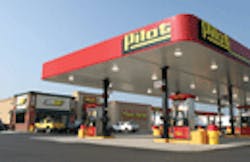DEF availability up while cost is down, says research firm
One of the concerns among trucking companies buying commercial trucks equipped with selective catalytic reduction (SCR) technology revolves around easy access to a critical ingredient required by this emission control system to reduce exhaust pollution down to government mandated levels: DEF, short for “diesel exhaust fluid.”
DEF is a liquid solution comprised of 67.5% de-ionized water and 32.5% urea, an ammonia compound, that’s sprayed into an SCR-equipped truck’s exhaust stream where it combines with a catalyst to break down oxides of nitrogen (NOx) into nitrogen and water. Without DEF, then, the SCR system doesn’t reduce NOx emissions.
Yet ongoing surveys of the U.S. and Canadian transportation markets by global consulting firm Integer Research finds that DEF availability is rapidly expanding, while the cost for this critical substance is dropping as well.
“As we moved into 2011, DEF consumption in the U.S. by Class 4 to 8 vehicles reached 2.3 million gallons per month, according to our consumption model,” Chris Goodfellow, emissions analyst at Integer, told Fleet Owner.
“The surprise was the rapid ramp up of demand in August and September, as manufacturers worked through 2009-model overhangs, rather than end-of-year sales volumes,” he explained. “In August, [DEF] consumption volumes increased by 43% compared to the previous month, and a number of suppliers reported sales volumes doubling in September alone. It was a relief, rather than a surprise, that volumes reached the expected levels.”
Goodfellow also noted that DEF pumps have been installed at 107 truck stops across North America, with Pilot Travel Centers LLC at the forefront with 69 locations, followed by Love’s with 26 – data Integer tracks through its dedicated DEF website.
“This level of development was expected; however, the big surprise has been the number of smaller retail chains which have made the significant capital investment necessary for at-the-pump DEF facilities,” he said. “This includes Bob Johnson Lubricants in Wisconsin, EZ GO in Oklahoma and Sapp Bros. in Nebraska.”
All told, over 3,400 sales locations now offer packaged DEF in the U.S. and Canada, usually in one or 2.5 gallon jugs, Goodfellow pointed out.
“In the first six months of 2010, when the number of SCR-equipped vehicles on the road was minimal, there were some concerns over the availability of DEF,” he added. “This centered around [SCR] customers located away from the major transport corridors and the disparity in pricing from dealerships which were charging large premiums on packaged products.”
With thousands of locations now stocking DEF and large capital investments in bulk storage by fleets, however, availability is no longer a major concern, Goodfellow said.
He also noted that the ”pump price” of DEF per gallon has declined steadily since last year, which is important as the lower the cost of DEF becomes, the lower the overall price of operating an SCR-equipped vehicle becomes – particularly in the face of rising diesel fuel costs.
“Most [truck] manufacturers calculated operating costs of new SCR-equipped vehicles based on a DEF price of $3 per gallon, but [the price] has been dropping since October in the U.S., when it was $2.99 per gallon,” Goodfellow explained. “DEF is now being priced on a location-by-location basis, much in the same way as diesel, and our data shows the price ranges from between $2.69 to $2.79 per gallon. It’s also likely to decrease further as the retail network develops.”
About the Author
Sean Kilcarr
Editor in Chief
Sean Kilcarr is a former longtime FleetOwner senior editor who wrote for the publication from 2000 to 2018. He served as editor-in-chief from 2017 to 2018.
